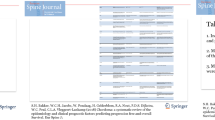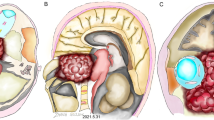Abstract
Purpose
Chordomas account for 1% to 4% of all bone malignancies and 0.5% of all primary intracranial central nervous system tumors. Prior epidemiologic literature is based on limited population data. The purpose of this study is to provide the largest and most inclusive population based study of the descriptive epidemiology of chordomas.
Methods
The Centers for Disease Control and Prevention and National Program of Cancer Registries were queried for chordoma in all locations. Age-adjusted incidence per 100,000 persons was calculated by age, sex, race, and ethnicity. Annual percentage change was calculated using Joinpoint.
Results
From 2004 to 2014, a total of 3670 chordomas were diagnosed in the US. The most common location was cranial (38.7%), followed by sacral (34.3%) and spinal (27.0%). The average age-adjusted incidence rate was 0.088 per 100,000 persons per year (95% CI 0.086–0.091), with an annual percentage change of 1.29% (95% CI 0.31–2.28%). For all chordomas, the incidence peaks in the 75–84 year age group. The male-to-female incidence rate ratio is 1.54 (p < 0.001). American Indian/Alaskan Native and Black patients had a statistically lower incidence rate than White and Asian/Pacific Islander patients.
Conclusion
Approximately 0.088 chordomas per 100,000 persons are newly diagnosed in the US each year, with cranial location being the most common, followed by sacral and spinal. Incidence increases with age, and men are at a significantly higher risk than women. This investigation represents the largest population-based epidemiologic study of chordomas in the US.



Similar content being viewed by others
Data availability
The authors confirm that the data supporting the findings of this study are available within the article and from the databases mentioned within.
Code availability
The code that supports the findings of this study are available from the corresponding author, upon reasonable request.
References
Report of Brain Tumor Registry of Japan (1984–2000) (2009). Neurol Med Chir (Tokyo) 49 Suppl:PS1–96
McMaster ML, Goldstein AM, Bromley CM, Ishibe N, Parry DM (2001) Chordoma: incidence and survival patterns in the United States, 1973–1995. Cancer Causes Control 12(1):1–11. https://doi.org/10.1023/a:1008947301735
Chugh R, Tawbi H, Lucas DR, Biermann JS, Schuetze SM, Baker LH (2007) Chordoma: the nonsarcoma primary bone tumor. Oncologist 12(11):1344–1350. https://doi.org/10.1634/theoncologist.12-11-1344
Heffelfinger MJ, Dahlin DC, MacCarty CS, Beabout JW (1973) Chordomas and cartilaginous tumors at the skull base. Cancer 32(2):410–420. https://doi.org/10.1002/1097-0142(197308)32:2%3c410:aid-cncr2820320219%3e3.0.co;2-s
Al-Mefty O, Borba LA (1997) Skull base chordomas: a management challenge. J Neurosurg 86(2):182–189. https://doi.org/10.3171/jns.1997.86.2.0182
Almefty K, Pravdenkova S, Colli BO, Al-Mefty O, Gokden M (2007) Chordoma and chondrosarcoma: similar, but quite different, skull base tumors. Cancer 110(11):2457–2467. https://doi.org/10.1002/cncr.23073
Lau CS, Mahendraraj K, Ward A, Chamberlain RS (2016) Pediatric chordomas: a population-based clinical outcome study involving 86 patients from the Surveillance, Epidemiology, and End Result (SEER) database (1973–2011). Pediatr Neurosurg 51(3):127–136. https://doi.org/10.1159/000442990
Surveillance, Epidemiology, and End Results (SEER) Program Populations (1969–2017). National Cancer Institue, DCCPS, Surveillance Resarch Program. www.seer.cancer.gov/popdata. Accessed 1 Apr 2019
NPCR and SEER Incidence-USCS 2001–2014 Public Use Database, Database standards and Data Dictionary. Centers for Disease Control and Prevention NCI. https://www.cdc.gov/cancer/npcr/public-use/2016. Accessed 1 Apr 2019
Ostrom QT, Gittleman H, Farah P, Ondracek A, Chen Y, Wolinsky Y, Stroup NE, Kruchko C, Barnholtz-Sloan JS (2013) CBTRUS statistical report: primary brain and central nervous system tumors diagnosed in the United States in 2006–2010. Neuro Oncol 15(Suppl 2):1–56. https://doi.org/10.1093/neuonc/not151
International classification of diseases for oncology (ICD-O) – 3rd edition, 1st revision. World Health Organization. https://apps.who.int/iris/handle/10665/96612. Accessed 1 Apr 2019
Jawad MU, Scully SP (2010) Surgery significantly improves survival in patients with chordoma. Spine (Phila Pa 1976) 35(1):117–123. https://doi.org/10.1097/BRS.0b013e3181b44387
Chambers KJ, Lin DT, Meier J, Remenschneider A, Herr M, Gray ST (2014) Incidence and survival patterns of cranial chordoma in the United States. Laryngoscope 124(5):1097–1102. https://doi.org/10.1002/lary.24420
Jones PS, Aghi MK, Muzikansky A, Shih HA, Barker FG 2nd, Curry WT Jr (2014) Outcomes and patterns of care in adult skull base chordomas from the Surveillance, Epidemiology, and End Results (SEER) database. J Clin Neurosci 21(9):1490–1496. https://doi.org/10.1016/j.jocn.2014.02.008
Smoll NR, Gautschi OP, Radovanovic I, Schaller K, Weber DC (2013) Incidence and relative survival of chordomas: the standardized mortality ratio and the impact of chordomas on a population. Cancer 119(11):2029–2037. https://doi.org/10.1002/cncr.28032
Rosenberg AE, Nielsen GP, Keel SB, Renard LG, Fitzek MM, Munzenrider JE, Liebsch NJ (1999) Chondrosarcoma of the base of the skull: a clinicopathologic study of 200 cases with emphasis on its distinction from chordoma. Am J Surg Pathol 23(11):1370–1378. https://doi.org/10.1097/00000478-199911000-00007
Kshettry VRYJ, Venur VA, Ahluwalia MS, Recinos PF (2017) Comprehensive management of chordoma. In: Raghavan D (ed) Textbook of uncommon cancer. Wiley, Hoboken, pp 847–855
Barresi V, Ieni A, Branca G, Tuccari G (2014) Brachyury: a diagnostic marker for the differential diagnosis of chordoma and hemangioblastoma versus neoplastic histological mimickers. Dis Mark 2014:514753. https://doi.org/10.1155/2014/514753
Vujovic S, Henderson S, Presneau N, Odell E, Jacques TS, Tirabosco R, Boshoff C, Flanagan AM (2006) Brachyury, a crucial regulator of notochordal development, is a novel biomarker for chordomas. J Pathol 209(2):157–165. https://doi.org/10.1002/path.1969
Kshettry VR, Hsieh JK, Ostrom QT, Kruchko C, Barnholtz-Sloan JS (2015) Incidence of vestibular schwannomas in the United States. J Neurooncol 124(2):223–228. https://doi.org/10.1007/s11060-015-1827-9
Kshettry VR, Ostrom QT, Kruchko C, Al-Mefty O, Barnett GH, Barnholtz-Sloan JS (2015) Descriptive epidemiology of World Health Organization grades II and III intracranial meningiomas in the United States. Neuro Oncol 17(8):1166–1173. https://doi.org/10.1093/neuonc/nov069
Miller KD, Goding Sauer A, Ortiz AP, Fedewa SA, Pinheiro PS, Tortolero-Luna G, Martinez-Tyson D, Jemal A, Seigel RL (2018) Cancer Statistics for Hispanics/Latinos. CA Cancer J Clin 68(6):425–445. https://doi.org/10.3322/caac.21494
Funding
Not applicable.
Author information
Authors and Affiliations
Corresponding author
Ethics declarations
Conflict of interest
Varun R. Kshettry is a consultant for Integra LifeSciences.
Additional information
Publisher's Note
Springer Nature remains neutral with regard to jurisdictional claims in published maps and institutional affiliations.
Rights and permissions
About this article
Cite this article
Das, P., Soni, P., Jones, J. et al. Descriptive epidemiology of chordomas in the United States. J Neurooncol 148, 173–178 (2020). https://doi.org/10.1007/s11060-020-03511-x
Received:
Accepted:
Published:
Issue Date:
DOI: https://doi.org/10.1007/s11060-020-03511-x




